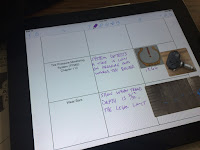Instructional Coaching at RMHS
This week I wanted to continue my post from last week and talk about my experiences with instructional coaching. As part of the Internal U course, Coaching Strategies for Classroom Success, one of our assignments was to videotape ourselves teaching so that we could reflect upon it. All of that got me thinking about the value that instructional coaching can have in my own classroom. So, in addition to asking Dawn, our TLF, to record my class for the homework assignment, I asked her to use it to complete a coaching cycle with me.
My first step was to pick a class to be observed. I chose a class in which my Honors Spanish 3 students would work in a station rotation model. I specifically chose this lesson plan because as part of station rotation, I would be working with one of the stations and have less contact with the students in the other stations. I liked the idea of Dawn recording my class so I could see what was happening in other groups while I was occupied with a fourth of the class. Dawn came and made a 40 minute video of my class.
 |
| Adapted from the Jim Knight Impact Cycle: This blog post will discuss Phases 1 & 2. Next week's post will discuss Phase 3. |
Overall the recording went well. I could tell that the students were a little quieter than normal in the beginning of class, but they seemed to get used to the camera (AKA my phone) pretty quickly. Last year I also had to record several of my classes as part of National Board certification and found the same thing to be true - a little awkward at first and then we were all fine.
Dawn recorded me during Block 2 and I was able to watch the video the following period. In order to give my viewing a concentration, I used this form. Watching myself on video was rough to start..but after I stopped focusing on my hair, my voice, and my overzealous hand gestures, I was able to view my teaching in a way to which I am not accustomed. The form allowed me to focus on specific, observable behaviors from both the students and me. In addition to using the scaled questions, I jotted down notes to myself.
Once I had a chance to watch the video, Dawn and I set an appointment for a coaching conversation. At that meeting we talked. Well, really what happened was that she asked questions and I reflected. It started with questions specifically about the lesson that had been recorded, using the form I filled out as our guide. From there Dawn helped me to reflect on how/if what I saw in the lesson fit into the course goal.
To be honest, I was surprised by how much I enjoyed the conversation. While I like talking with Dawn, and do so regularly as part of our roles as TLF & DTC, I was nervous about what it would feel like to be in a conversation like this with her. I knew that it wasn’t an evaluative conversation, but it took a few minutes for me to let go of that feeling. Also, part of me was curious if someone not in my content area could help me.
In reality, the conversation was really great and really helpful. Like I said, we used the form to guide our conversation and Dawn simply asked me lots of questions to help me reflect on my own teaching. I regularly work on reflecting on my lessons...and this was different. I felt like the questions asked helped me to think about some of the larger course goals and how what we were doing in those lessons related to them.
At the end of the conversation, with Dawn’s help, I set some goals and created my next steps. Check out next week’s blog to read more about PEERS goals and the next steps in the coaching cycle.


Comments
Post a Comment